Financial Management Report: M&S Financial Analysis and Strategies
VerifiedAdded on 2023/01/13
|18
|3153
|61
Report
AI Summary
This report provides a comprehensive analysis of the financial management practices of Marks and Spencer (M&S). It begins with an introduction to financial management, outlining planning and control functions. The report then delves into M&S's operations, covering financial management approaches, techniques, and factors involved in financial decision-making. It explores operational and strategic decision-making using financial data, including investment appraisal techniques such as Payback Period, Net Present Value (NPV), and Internal Rate of Return (IRR). The report also examines techniques used in financial management decision-making, such as cash flow statements and break-even analysis, and discusses how financial decisions support long-term sustainability. Furthermore, it analyzes profitability, liquidity, and solvency ratios to assess M&S's financial performance, providing insights into the company's strengths and weaknesses. The report concludes with recommendations for improving M&S's financial strategies and performance, offering valuable insights for students studying finance and business management.

Paraphrase This Document
Need a fresh take? Get an instant paraphrase of this document with our AI Paraphraser

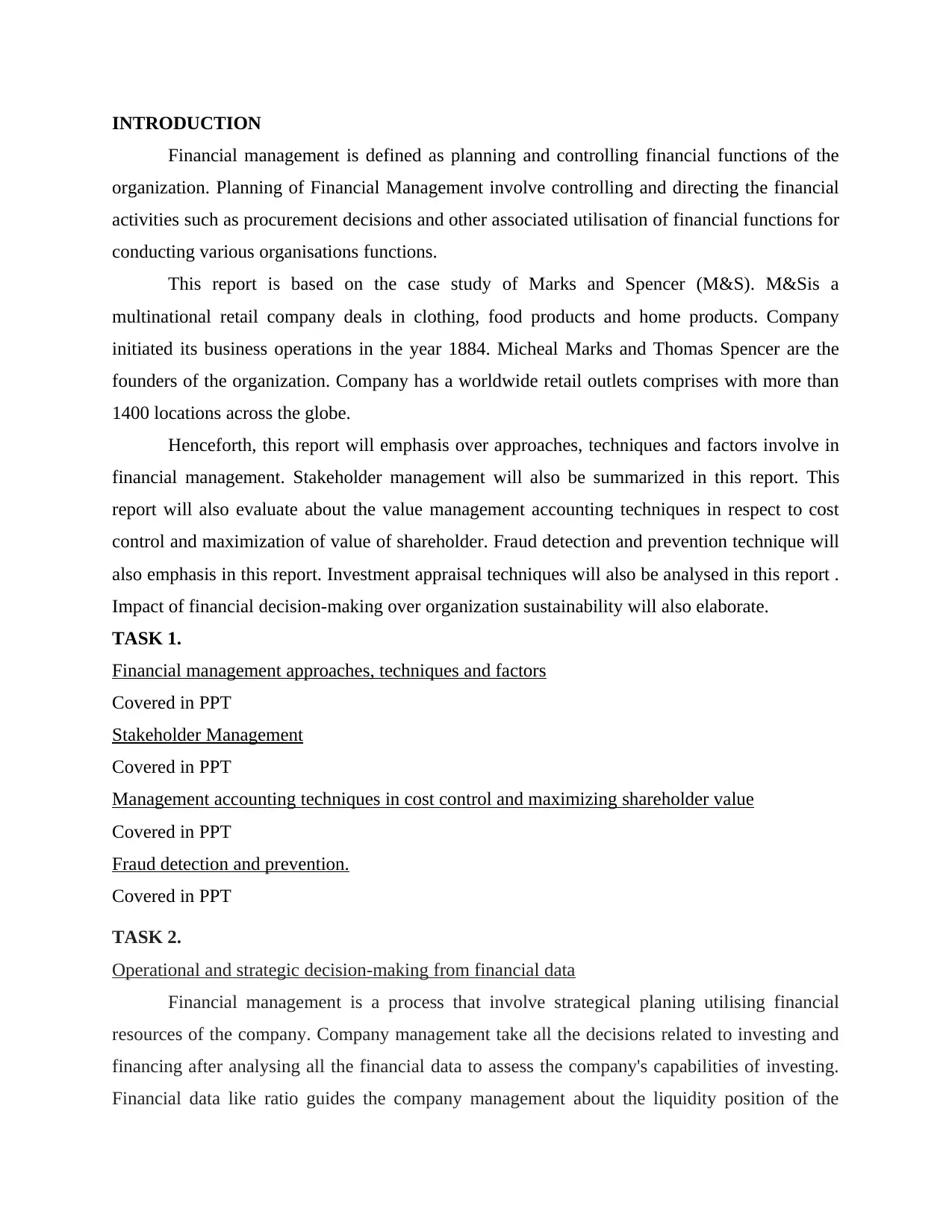
INTRODUCTION
Financial management is defined as planning and controlling financial functions of the
organization. Planning of Financial Management involve controlling and directing the financial
activities such as procurement decisions and other associated utilisation of financial functions for
conducting various organisations functions.
This report is based on the case study of Marks and Spencer (M&S). M&Sis a
multinational retail company deals in clothing, food products and home products. Company
initiated its business operations in the year 1884. Micheal Marks and Thomas Spencer are the
founders of the organization. Company has a worldwide retail outlets comprises with more than
1400 locations across the globe.
Henceforth, this report will emphasis over approaches, techniques and factors involve in
financial management. Stakeholder management will also be summarized in this report. This
report will also evaluate about the value management accounting techniques in respect to cost
control and maximization of value of shareholder. Fraud detection and prevention technique will
also emphasis in this report. Investment appraisal techniques will also be analysed in this report .
Impact of financial decision-making over organization sustainability will also elaborate.
TASK 1.
Financial management approaches, techniques and factors
Covered in PPT
Stakeholder Management
Covered in PPT
Management accounting techniques in cost control and maximizing shareholder value
Covered in PPT
Fraud detection and prevention.
Covered in PPT
TASK 2.
Operational and strategic decision-making from financial data
Financial management is a process that involve strategical planing utilising financial
resources of the company. Company management take all the decisions related to investing and
financing after analysing all the financial data to assess the company's capabilities of investing.
Financial data like ratio guides the company management about the liquidity position of the
Financial management is defined as planning and controlling financial functions of the
organization. Planning of Financial Management involve controlling and directing the financial
activities such as procurement decisions and other associated utilisation of financial functions for
conducting various organisations functions.
This report is based on the case study of Marks and Spencer (M&S). M&Sis a
multinational retail company deals in clothing, food products and home products. Company
initiated its business operations in the year 1884. Micheal Marks and Thomas Spencer are the
founders of the organization. Company has a worldwide retail outlets comprises with more than
1400 locations across the globe.
Henceforth, this report will emphasis over approaches, techniques and factors involve in
financial management. Stakeholder management will also be summarized in this report. This
report will also evaluate about the value management accounting techniques in respect to cost
control and maximization of value of shareholder. Fraud detection and prevention technique will
also emphasis in this report. Investment appraisal techniques will also be analysed in this report .
Impact of financial decision-making over organization sustainability will also elaborate.
TASK 1.
Financial management approaches, techniques and factors
Covered in PPT
Stakeholder Management
Covered in PPT
Management accounting techniques in cost control and maximizing shareholder value
Covered in PPT
Fraud detection and prevention.
Covered in PPT
TASK 2.
Operational and strategic decision-making from financial data
Financial management is a process that involve strategical planing utilising financial
resources of the company. Company management take all the decisions related to investing and
financing after analysing all the financial data to assess the company's capabilities of investing.
Financial data like ratio guides the company management about the liquidity position of the
⊘ This is a preview!⊘
Do you want full access?
Subscribe today to unlock all pages.

Trusted by 1+ million students worldwide
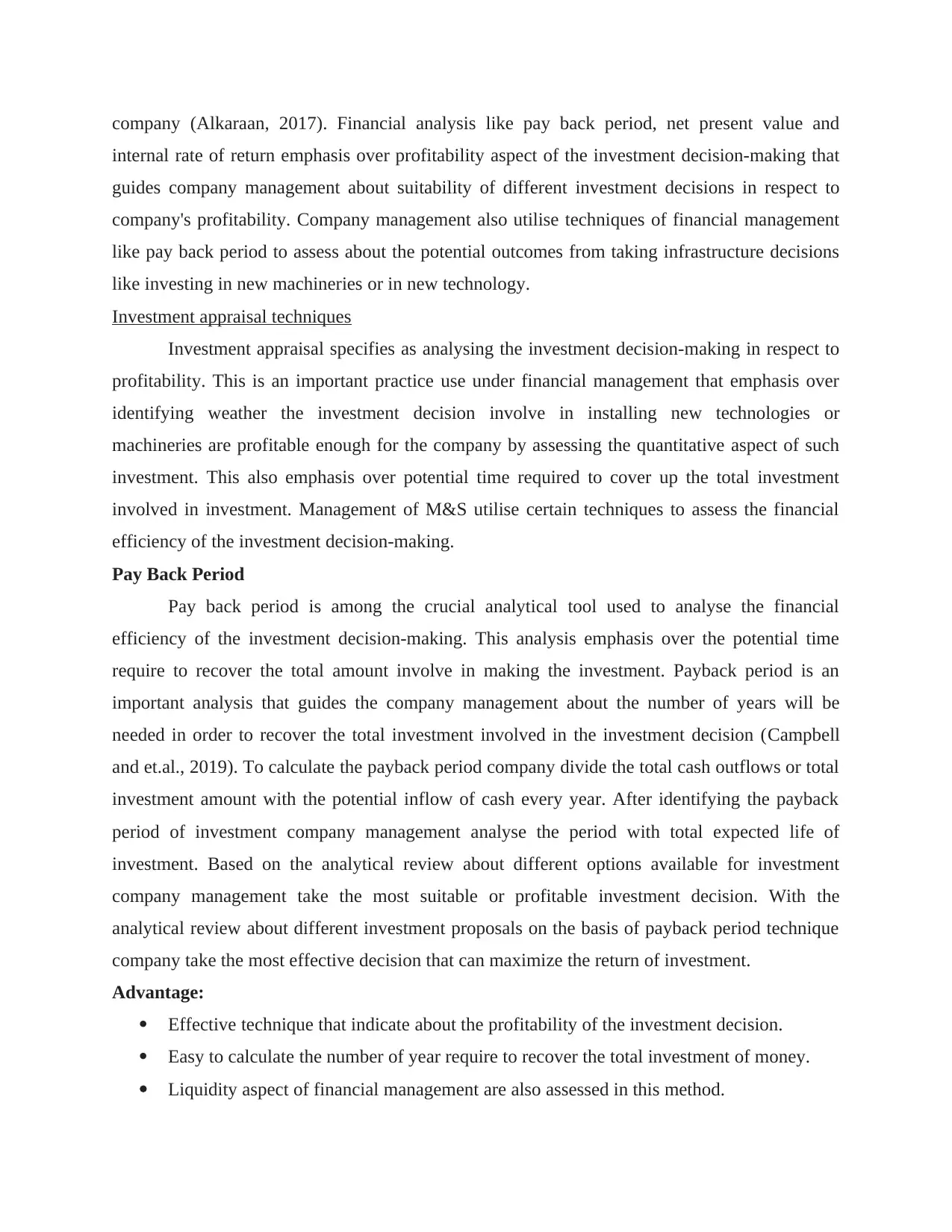
company (Alkaraan, 2017). Financial analysis like pay back period, net present value and
internal rate of return emphasis over profitability aspect of the investment decision-making that
guides company management about suitability of different investment decisions in respect to
company's profitability. Company management also utilise techniques of financial management
like pay back period to assess about the potential outcomes from taking infrastructure decisions
like investing in new machineries or in new technology.
Investment appraisal techniques
Investment appraisal specifies as analysing the investment decision-making in respect to
profitability. This is an important practice use under financial management that emphasis over
identifying weather the investment decision involve in installing new technologies or
machineries are profitable enough for the company by assessing the quantitative aspect of such
investment. This also emphasis over potential time required to cover up the total investment
involved in investment. Management of M&S utilise certain techniques to assess the financial
efficiency of the investment decision-making.
Pay Back Period
Pay back period is among the crucial analytical tool used to analyse the financial
efficiency of the investment decision-making. This analysis emphasis over the potential time
require to recover the total amount involve in making the investment. Payback period is an
important analysis that guides the company management about the number of years will be
needed in order to recover the total investment involved in the investment decision (Campbell
and et.al., 2019). To calculate the payback period company divide the total cash outflows or total
investment amount with the potential inflow of cash every year. After identifying the payback
period of investment company management analyse the period with total expected life of
investment. Based on the analytical review about different options available for investment
company management take the most suitable or profitable investment decision. With the
analytical review about different investment proposals on the basis of payback period technique
company take the most effective decision that can maximize the return of investment.
Advantage:
Effective technique that indicate about the profitability of the investment decision.
Easy to calculate the number of year require to recover the total investment of money.
Liquidity aspect of financial management are also assessed in this method.
internal rate of return emphasis over profitability aspect of the investment decision-making that
guides company management about suitability of different investment decisions in respect to
company's profitability. Company management also utilise techniques of financial management
like pay back period to assess about the potential outcomes from taking infrastructure decisions
like investing in new machineries or in new technology.
Investment appraisal techniques
Investment appraisal specifies as analysing the investment decision-making in respect to
profitability. This is an important practice use under financial management that emphasis over
identifying weather the investment decision involve in installing new technologies or
machineries are profitable enough for the company by assessing the quantitative aspect of such
investment. This also emphasis over potential time required to cover up the total investment
involved in investment. Management of M&S utilise certain techniques to assess the financial
efficiency of the investment decision-making.
Pay Back Period
Pay back period is among the crucial analytical tool used to analyse the financial
efficiency of the investment decision-making. This analysis emphasis over the potential time
require to recover the total amount involve in making the investment. Payback period is an
important analysis that guides the company management about the number of years will be
needed in order to recover the total investment involved in the investment decision (Campbell
and et.al., 2019). To calculate the payback period company divide the total cash outflows or total
investment amount with the potential inflow of cash every year. After identifying the payback
period of investment company management analyse the period with total expected life of
investment. Based on the analytical review about different options available for investment
company management take the most suitable or profitable investment decision. With the
analytical review about different investment proposals on the basis of payback period technique
company take the most effective decision that can maximize the return of investment.
Advantage:
Effective technique that indicate about the profitability of the investment decision.
Easy to calculate the number of year require to recover the total investment of money.
Liquidity aspect of financial management are also assessed in this method.
Paraphrase This Document
Need a fresh take? Get an instant paraphrase of this document with our AI Paraphraser
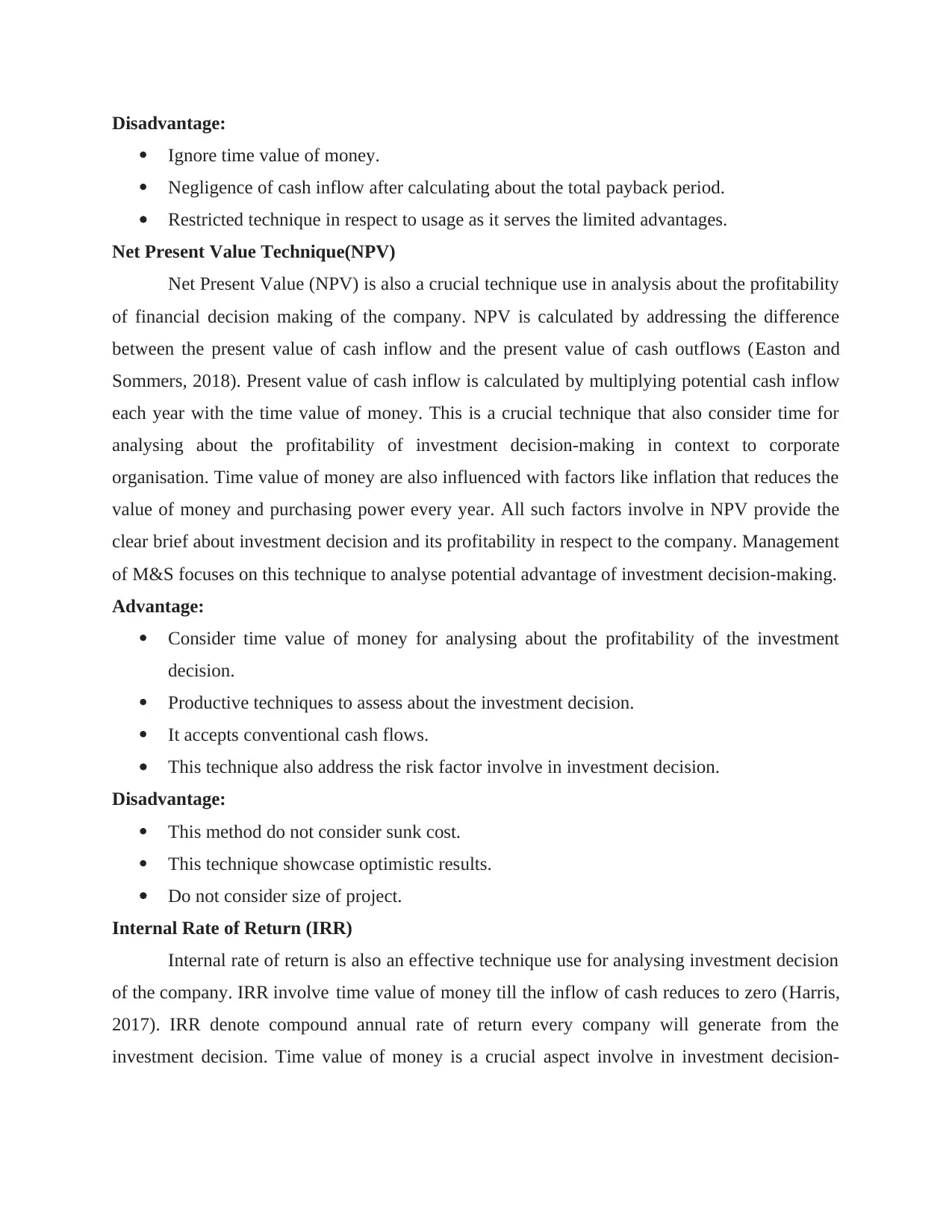
Disadvantage:
Ignore time value of money.
Negligence of cash inflow after calculating about the total payback period.
Restricted technique in respect to usage as it serves the limited advantages.
Net Present Value Technique(NPV)
Net Present Value (NPV) is also a crucial technique use in analysis about the profitability
of financial decision making of the company. NPV is calculated by addressing the difference
between the present value of cash inflow and the present value of cash outflows (Easton and
Sommers, 2018). Present value of cash inflow is calculated by multiplying potential cash inflow
each year with the time value of money. This is a crucial technique that also consider time for
analysing about the profitability of investment decision-making in context to corporate
organisation. Time value of money are also influenced with factors like inflation that reduces the
value of money and purchasing power every year. All such factors involve in NPV provide the
clear brief about investment decision and its profitability in respect to the company. Management
of M&S focuses on this technique to analyse potential advantage of investment decision-making.
Advantage:
Consider time value of money for analysing about the profitability of the investment
decision.
Productive techniques to assess about the investment decision.
It accepts conventional cash flows.
This technique also address the risk factor involve in investment decision.
Disadvantage:
This method do not consider sunk cost.
This technique showcase optimistic results.
Do not consider size of project.
Internal Rate of Return (IRR)
Internal rate of return is also an effective technique use for analysing investment decision
of the company. IRR involve time value of money till the inflow of cash reduces to zero (Harris,
2017). IRR denote compound annual rate of return every company will generate from the
investment decision. Time value of money is a crucial aspect involve in investment decision-
Ignore time value of money.
Negligence of cash inflow after calculating about the total payback period.
Restricted technique in respect to usage as it serves the limited advantages.
Net Present Value Technique(NPV)
Net Present Value (NPV) is also a crucial technique use in analysis about the profitability
of financial decision making of the company. NPV is calculated by addressing the difference
between the present value of cash inflow and the present value of cash outflows (Easton and
Sommers, 2018). Present value of cash inflow is calculated by multiplying potential cash inflow
each year with the time value of money. This is a crucial technique that also consider time for
analysing about the profitability of investment decision-making in context to corporate
organisation. Time value of money are also influenced with factors like inflation that reduces the
value of money and purchasing power every year. All such factors involve in NPV provide the
clear brief about investment decision and its profitability in respect to the company. Management
of M&S focuses on this technique to analyse potential advantage of investment decision-making.
Advantage:
Consider time value of money for analysing about the profitability of the investment
decision.
Productive techniques to assess about the investment decision.
It accepts conventional cash flows.
This technique also address the risk factor involve in investment decision.
Disadvantage:
This method do not consider sunk cost.
This technique showcase optimistic results.
Do not consider size of project.
Internal Rate of Return (IRR)
Internal rate of return is also an effective technique use for analysing investment decision
of the company. IRR involve time value of money till the inflow of cash reduces to zero (Harris,
2017). IRR denote compound annual rate of return every company will generate from the
investment decision. Time value of money is a crucial aspect involve in investment decision-
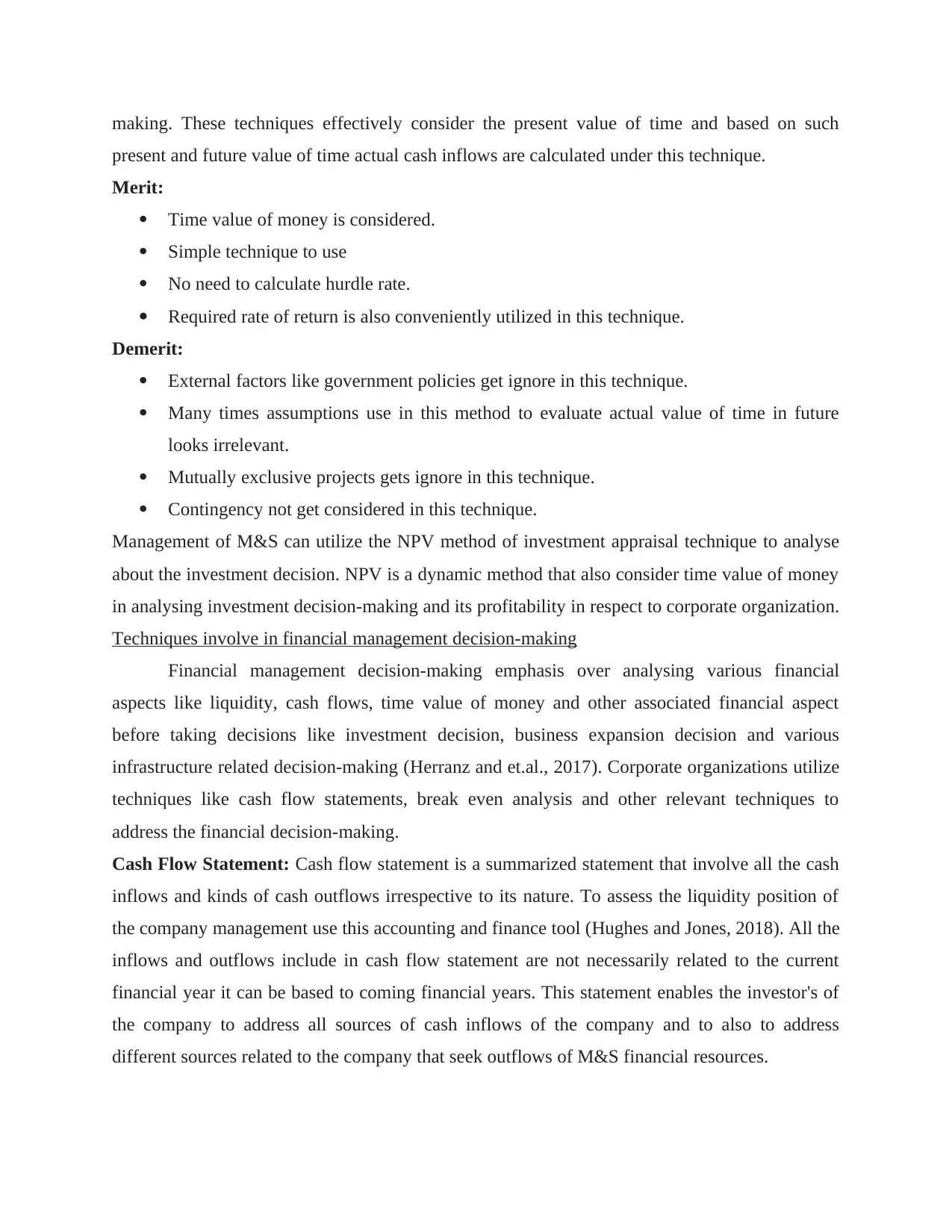
making. These techniques effectively consider the present value of time and based on such
present and future value of time actual cash inflows are calculated under this technique.
Merit:
Time value of money is considered.
Simple technique to use
No need to calculate hurdle rate.
Required rate of return is also conveniently utilized in this technique.
Demerit:
External factors like government policies get ignore in this technique.
Many times assumptions use in this method to evaluate actual value of time in future
looks irrelevant.
Mutually exclusive projects gets ignore in this technique.
Contingency not get considered in this technique.
Management of M&S can utilize the NPV method of investment appraisal technique to analyse
about the investment decision. NPV is a dynamic method that also consider time value of money
in analysing investment decision-making and its profitability in respect to corporate organization.
Techniques involve in financial management decision-making
Financial management decision-making emphasis over analysing various financial
aspects like liquidity, cash flows, time value of money and other associated financial aspect
before taking decisions like investment decision, business expansion decision and various
infrastructure related decision-making (Herranz and et.al., 2017). Corporate organizations utilize
techniques like cash flow statements, break even analysis and other relevant techniques to
address the financial decision-making.
Cash Flow Statement: Cash flow statement is a summarized statement that involve all the cash
inflows and kinds of cash outflows irrespective to its nature. To assess the liquidity position of
the company management use this accounting and finance tool (Hughes and Jones, 2018). All the
inflows and outflows include in cash flow statement are not necessarily related to the current
financial year it can be based to coming financial years. This statement enables the investor's of
the company to address all sources of cash inflows of the company and to also to address
different sources related to the company that seek outflows of M&S financial resources.
present and future value of time actual cash inflows are calculated under this technique.
Merit:
Time value of money is considered.
Simple technique to use
No need to calculate hurdle rate.
Required rate of return is also conveniently utilized in this technique.
Demerit:
External factors like government policies get ignore in this technique.
Many times assumptions use in this method to evaluate actual value of time in future
looks irrelevant.
Mutually exclusive projects gets ignore in this technique.
Contingency not get considered in this technique.
Management of M&S can utilize the NPV method of investment appraisal technique to analyse
about the investment decision. NPV is a dynamic method that also consider time value of money
in analysing investment decision-making and its profitability in respect to corporate organization.
Techniques involve in financial management decision-making
Financial management decision-making emphasis over analysing various financial
aspects like liquidity, cash flows, time value of money and other associated financial aspect
before taking decisions like investment decision, business expansion decision and various
infrastructure related decision-making (Herranz and et.al., 2017). Corporate organizations utilize
techniques like cash flow statements, break even analysis and other relevant techniques to
address the financial decision-making.
Cash Flow Statement: Cash flow statement is a summarized statement that involve all the cash
inflows and kinds of cash outflows irrespective to its nature. To assess the liquidity position of
the company management use this accounting and finance tool (Hughes and Jones, 2018). All the
inflows and outflows include in cash flow statement are not necessarily related to the current
financial year it can be based to coming financial years. This statement enables the investor's of
the company to address all sources of cash inflows of the company and to also to address
different sources related to the company that seek outflows of M&S financial resources.
⊘ This is a preview!⊘
Do you want full access?
Subscribe today to unlock all pages.

Trusted by 1+ million students worldwide
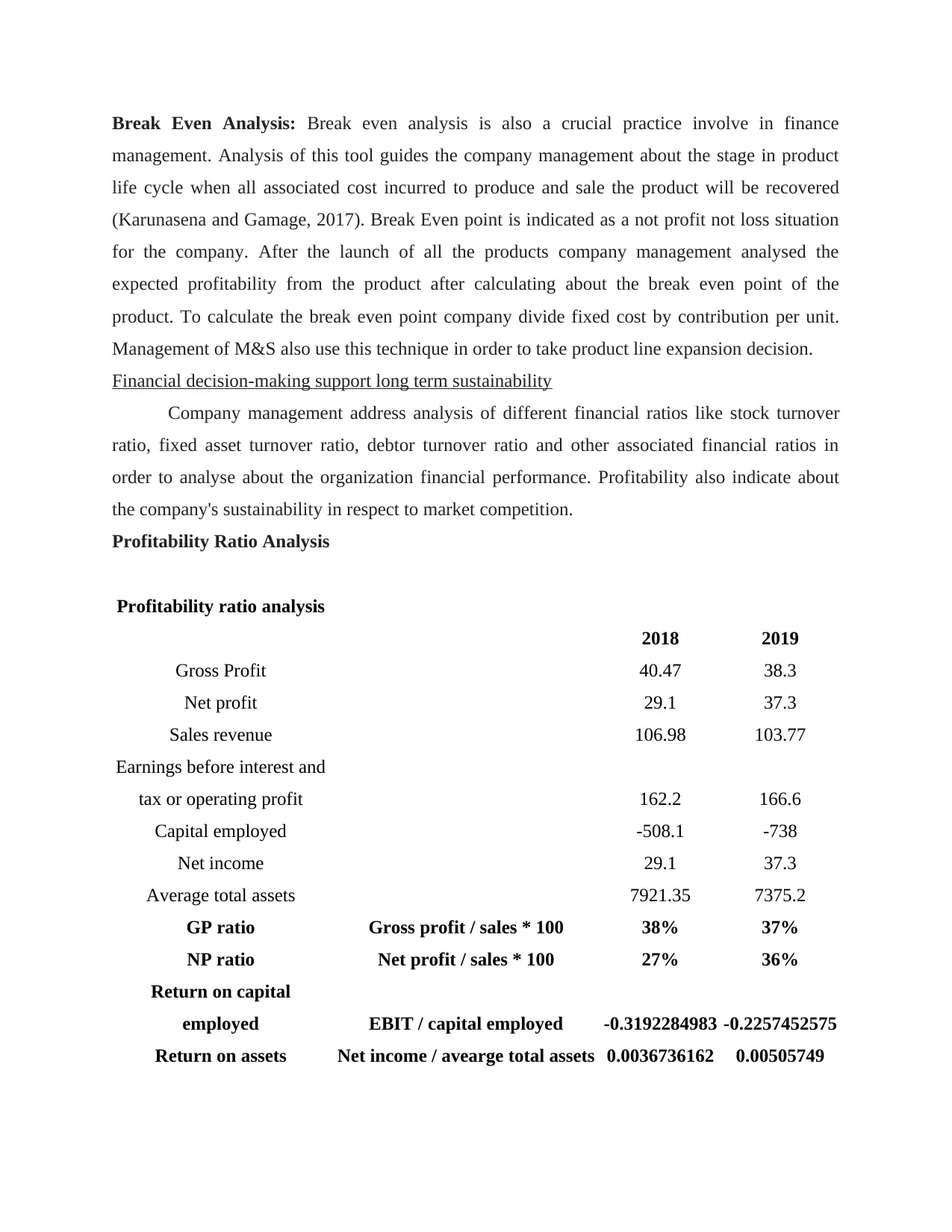
Break Even Analysis: Break even analysis is also a crucial practice involve in finance
management. Analysis of this tool guides the company management about the stage in product
life cycle when all associated cost incurred to produce and sale the product will be recovered
(Karunasena and Gamage, 2017). Break Even point is indicated as a not profit not loss situation
for the company. After the launch of all the products company management analysed the
expected profitability from the product after calculating about the break even point of the
product. To calculate the break even point company divide fixed cost by contribution per unit.
Management of M&S also use this technique in order to take product line expansion decision.
Financial decision-making support long term sustainability
Company management address analysis of different financial ratios like stock turnover
ratio, fixed asset turnover ratio, debtor turnover ratio and other associated financial ratios in
order to analyse about the organization financial performance. Profitability also indicate about
the company's sustainability in respect to market competition.
Profitability Ratio Analysis
Profitability ratio analysis
2018 2019
Gross Profit 40.47 38.3
Net profit 29.1 37.3
Sales revenue 106.98 103.77
Earnings before interest and
tax or operating profit 162.2 166.6
Capital employed -508.1 -738
Net income 29.1 37.3
Average total assets 7921.35 7375.2
GP ratio Gross profit / sales * 100 38% 37%
NP ratio Net profit / sales * 100 27% 36%
Return on capital
employed EBIT / capital employed -0.3192284983 -0.2257452575
Return on assets Net income / avearge total assets 0.0036736162 0.00505749
management. Analysis of this tool guides the company management about the stage in product
life cycle when all associated cost incurred to produce and sale the product will be recovered
(Karunasena and Gamage, 2017). Break Even point is indicated as a not profit not loss situation
for the company. After the launch of all the products company management analysed the
expected profitability from the product after calculating about the break even point of the
product. To calculate the break even point company divide fixed cost by contribution per unit.
Management of M&S also use this technique in order to take product line expansion decision.
Financial decision-making support long term sustainability
Company management address analysis of different financial ratios like stock turnover
ratio, fixed asset turnover ratio, debtor turnover ratio and other associated financial ratios in
order to analyse about the organization financial performance. Profitability also indicate about
the company's sustainability in respect to market competition.
Profitability Ratio Analysis
Profitability ratio analysis
2018 2019
Gross Profit 40.47 38.3
Net profit 29.1 37.3
Sales revenue 106.98 103.77
Earnings before interest and
tax or operating profit 162.2 166.6
Capital employed -508.1 -738
Net income 29.1 37.3
Average total assets 7921.35 7375.2
GP ratio Gross profit / sales * 100 38% 37%
NP ratio Net profit / sales * 100 27% 36%
Return on capital
employed EBIT / capital employed -0.3192284983 -0.2257452575
Return on assets Net income / avearge total assets 0.0036736162 0.00505749
Paraphrase This Document
Need a fresh take? Get an instant paraphrase of this document with our AI Paraphraser
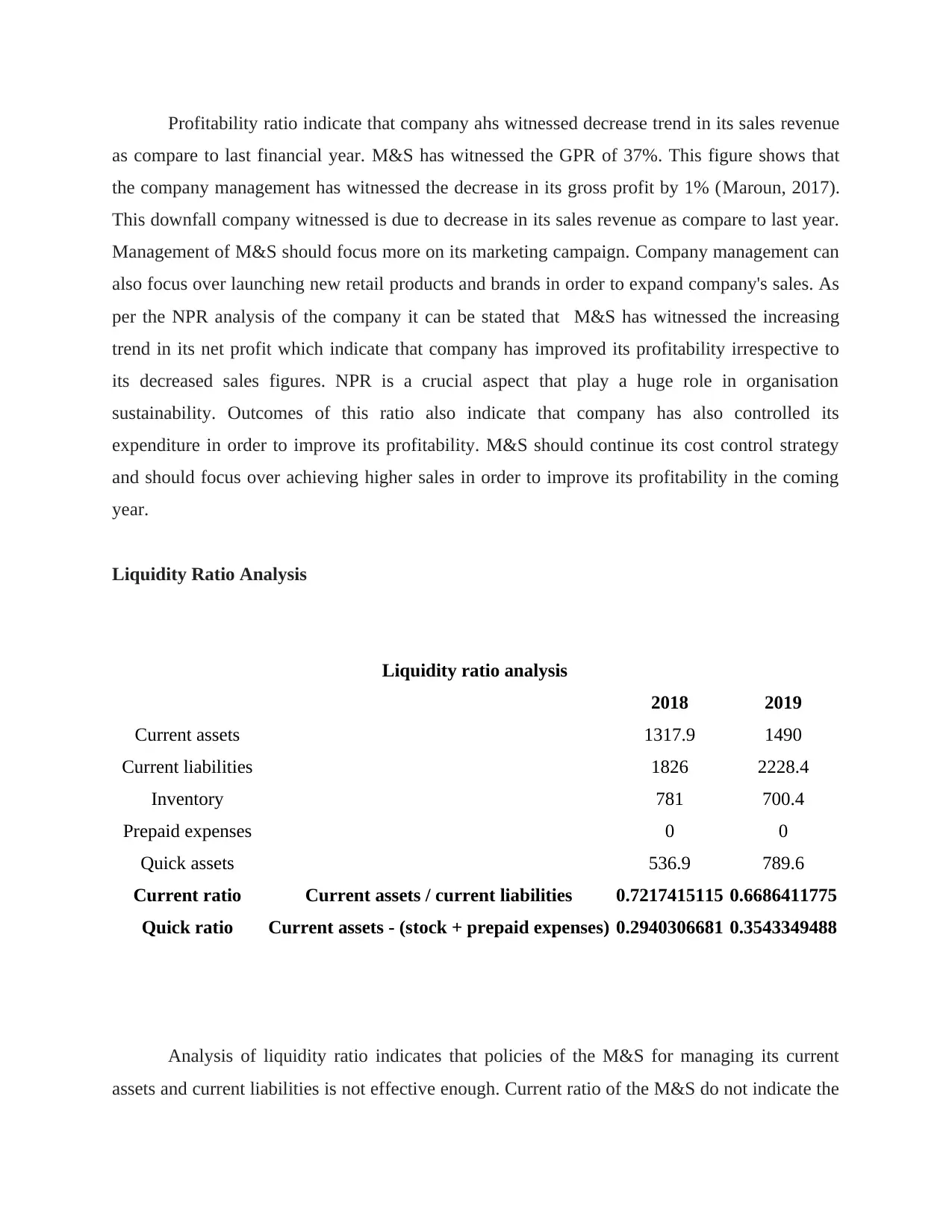
Profitability ratio indicate that company ahs witnessed decrease trend in its sales revenue
as compare to last financial year. M&S has witnessed the GPR of 37%. This figure shows that
the company management has witnessed the decrease in its gross profit by 1% (Maroun, 2017).
This downfall company witnessed is due to decrease in its sales revenue as compare to last year.
Management of M&S should focus more on its marketing campaign. Company management can
also focus over launching new retail products and brands in order to expand company's sales. As
per the NPR analysis of the company it can be stated that M&S has witnessed the increasing
trend in its net profit which indicate that company has improved its profitability irrespective to
its decreased sales figures. NPR is a crucial aspect that play a huge role in organisation
sustainability. Outcomes of this ratio also indicate that company has also controlled its
expenditure in order to improve its profitability. M&S should continue its cost control strategy
and should focus over achieving higher sales in order to improve its profitability in the coming
year.
Liquidity Ratio Analysis
Liquidity ratio analysis
2018 2019
Current assets 1317.9 1490
Current liabilities 1826 2228.4
Inventory 781 700.4
Prepaid expenses 0 0
Quick assets 536.9 789.6
Current ratio Current assets / current liabilities 0.7217415115 0.6686411775
Quick ratio Current assets - (stock + prepaid expenses) 0.2940306681 0.3543349488
Analysis of liquidity ratio indicates that policies of the M&S for managing its current
assets and current liabilities is not effective enough. Current ratio of the M&S do not indicate the
as compare to last financial year. M&S has witnessed the GPR of 37%. This figure shows that
the company management has witnessed the decrease in its gross profit by 1% (Maroun, 2017).
This downfall company witnessed is due to decrease in its sales revenue as compare to last year.
Management of M&S should focus more on its marketing campaign. Company management can
also focus over launching new retail products and brands in order to expand company's sales. As
per the NPR analysis of the company it can be stated that M&S has witnessed the increasing
trend in its net profit which indicate that company has improved its profitability irrespective to
its decreased sales figures. NPR is a crucial aspect that play a huge role in organisation
sustainability. Outcomes of this ratio also indicate that company has also controlled its
expenditure in order to improve its profitability. M&S should continue its cost control strategy
and should focus over achieving higher sales in order to improve its profitability in the coming
year.
Liquidity Ratio Analysis
Liquidity ratio analysis
2018 2019
Current assets 1317.9 1490
Current liabilities 1826 2228.4
Inventory 781 700.4
Prepaid expenses 0 0
Quick assets 536.9 789.6
Current ratio Current assets / current liabilities 0.7217415115 0.6686411775
Quick ratio Current assets - (stock + prepaid expenses) 0.2940306681 0.3543349488
Analysis of liquidity ratio indicates that policies of the M&S for managing its current
assets and current liabilities is not effective enough. Current ratio of the M&S do not indicate the
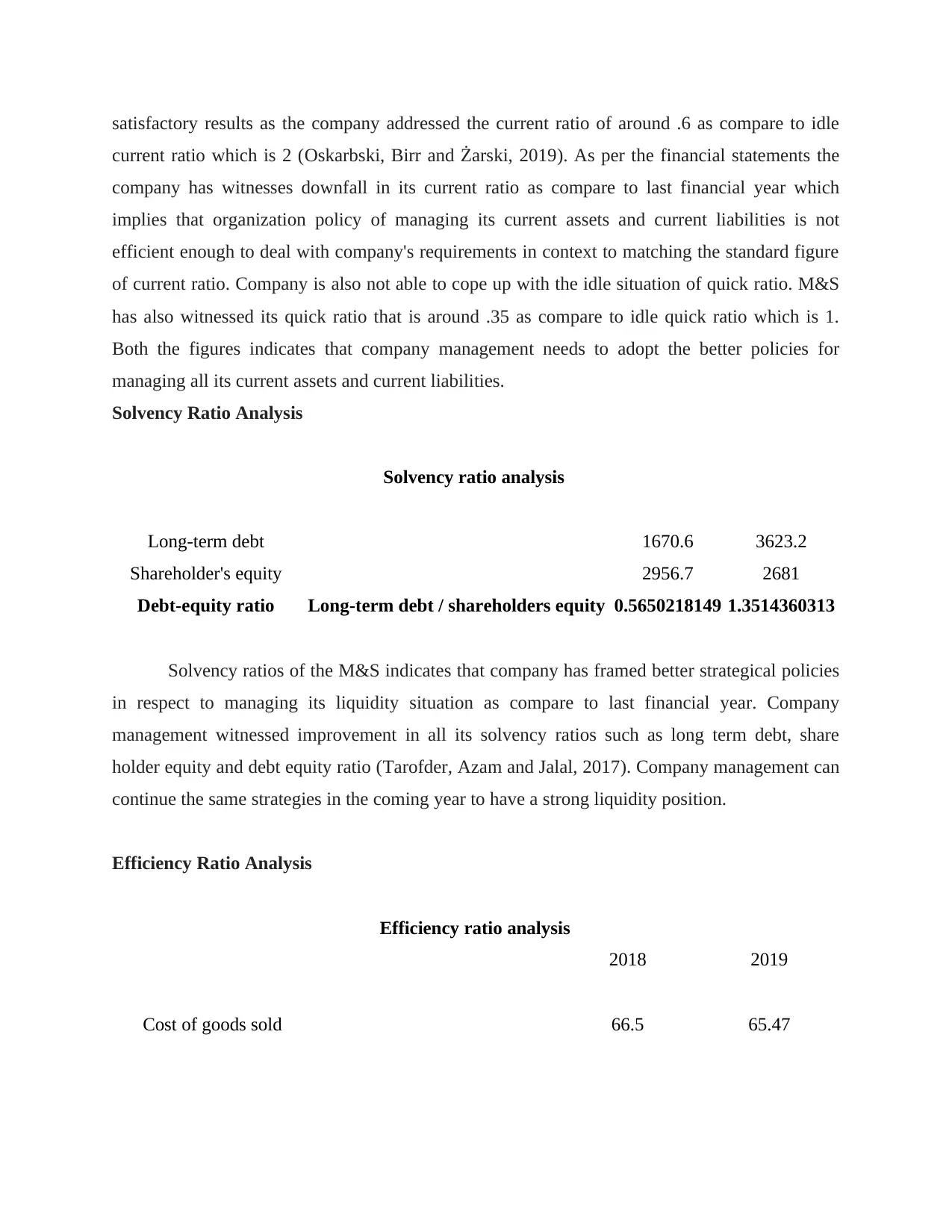
satisfactory results as the company addressed the current ratio of around .6 as compare to idle
current ratio which is 2 (Oskarbski, Birr and Żarski, 2019). As per the financial statements the
company has witnesses downfall in its current ratio as compare to last financial year which
implies that organization policy of managing its current assets and current liabilities is not
efficient enough to deal with company's requirements in context to matching the standard figure
of current ratio. Company is also not able to cope up with the idle situation of quick ratio. M&S
has also witnessed its quick ratio that is around .35 as compare to idle quick ratio which is 1.
Both the figures indicates that company management needs to adopt the better policies for
managing all its current assets and current liabilities.
Solvency Ratio Analysis
Solvency ratio analysis
Long-term debt 1670.6 3623.2
Shareholder's equity 2956.7 2681
Debt-equity ratio Long-term debt / shareholders equity 0.5650218149 1.3514360313
Solvency ratios of the M&S indicates that company has framed better strategical policies
in respect to managing its liquidity situation as compare to last financial year. Company
management witnessed improvement in all its solvency ratios such as long term debt, share
holder equity and debt equity ratio (Tarofder, Azam and Jalal, 2017). Company management can
continue the same strategies in the coming year to have a strong liquidity position.
Efficiency Ratio Analysis
Efficiency ratio analysis
2018 2019
Cost of goods sold 66.5 65.47
current ratio which is 2 (Oskarbski, Birr and Żarski, 2019). As per the financial statements the
company has witnesses downfall in its current ratio as compare to last financial year which
implies that organization policy of managing its current assets and current liabilities is not
efficient enough to deal with company's requirements in context to matching the standard figure
of current ratio. Company is also not able to cope up with the idle situation of quick ratio. M&S
has also witnessed its quick ratio that is around .35 as compare to idle quick ratio which is 1.
Both the figures indicates that company management needs to adopt the better policies for
managing all its current assets and current liabilities.
Solvency Ratio Analysis
Solvency ratio analysis
Long-term debt 1670.6 3623.2
Shareholder's equity 2956.7 2681
Debt-equity ratio Long-term debt / shareholders equity 0.5650218149 1.3514360313
Solvency ratios of the M&S indicates that company has framed better strategical policies
in respect to managing its liquidity situation as compare to last financial year. Company
management witnessed improvement in all its solvency ratios such as long term debt, share
holder equity and debt equity ratio (Tarofder, Azam and Jalal, 2017). Company management can
continue the same strategies in the coming year to have a strong liquidity position.
Efficiency Ratio Analysis
Efficiency ratio analysis
2018 2019
Cost of goods sold 66.5 65.47
⊘ This is a preview!⊘
Do you want full access?
Subscribe today to unlock all pages.

Trusted by 1+ million students worldwide
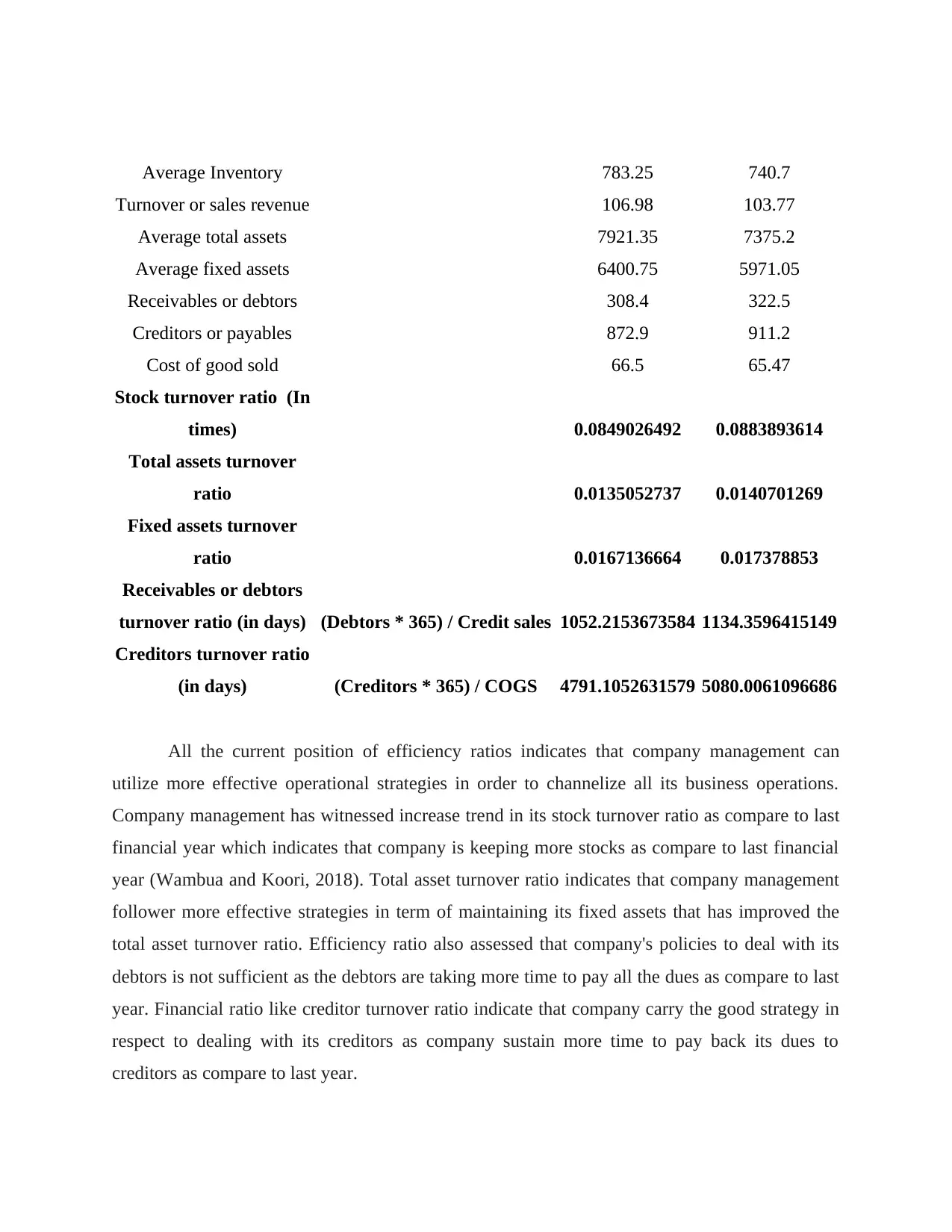
Average Inventory 783.25 740.7
Turnover or sales revenue 106.98 103.77
Average total assets 7921.35 7375.2
Average fixed assets 6400.75 5971.05
Receivables or debtors 308.4 322.5
Creditors or payables 872.9 911.2
Cost of good sold 66.5 65.47
Stock turnover ratio (In
times) 0.0849026492 0.0883893614
Total assets turnover
ratio 0.0135052737 0.0140701269
Fixed assets turnover
ratio 0.0167136664 0.017378853
Receivables or debtors
turnover ratio (in days) (Debtors * 365) / Credit sales 1052.2153673584 1134.3596415149
Creditors turnover ratio
(in days) (Creditors * 365) / COGS 4791.1052631579 5080.0061096686
All the current position of efficiency ratios indicates that company management can
utilize more effective operational strategies in order to channelize all its business operations.
Company management has witnessed increase trend in its stock turnover ratio as compare to last
financial year which indicates that company is keeping more stocks as compare to last financial
year (Wambua and Koori, 2018). Total asset turnover ratio indicates that company management
follower more effective strategies in term of maintaining its fixed assets that has improved the
total asset turnover ratio. Efficiency ratio also assessed that company's policies to deal with its
debtors is not sufficient as the debtors are taking more time to pay all the dues as compare to last
year. Financial ratio like creditor turnover ratio indicate that company carry the good strategy in
respect to dealing with its creditors as company sustain more time to pay back its dues to
creditors as compare to last year.
Turnover or sales revenue 106.98 103.77
Average total assets 7921.35 7375.2
Average fixed assets 6400.75 5971.05
Receivables or debtors 308.4 322.5
Creditors or payables 872.9 911.2
Cost of good sold 66.5 65.47
Stock turnover ratio (In
times) 0.0849026492 0.0883893614
Total assets turnover
ratio 0.0135052737 0.0140701269
Fixed assets turnover
ratio 0.0167136664 0.017378853
Receivables or debtors
turnover ratio (in days) (Debtors * 365) / Credit sales 1052.2153673584 1134.3596415149
Creditors turnover ratio
(in days) (Creditors * 365) / COGS 4791.1052631579 5080.0061096686
All the current position of efficiency ratios indicates that company management can
utilize more effective operational strategies in order to channelize all its business operations.
Company management has witnessed increase trend in its stock turnover ratio as compare to last
financial year which indicates that company is keeping more stocks as compare to last financial
year (Wambua and Koori, 2018). Total asset turnover ratio indicates that company management
follower more effective strategies in term of maintaining its fixed assets that has improved the
total asset turnover ratio. Efficiency ratio also assessed that company's policies to deal with its
debtors is not sufficient as the debtors are taking more time to pay all the dues as compare to last
year. Financial ratio like creditor turnover ratio indicate that company carry the good strategy in
respect to dealing with its creditors as company sustain more time to pay back its dues to
creditors as compare to last year.
Paraphrase This Document
Need a fresh take? Get an instant paraphrase of this document with our AI Paraphraser
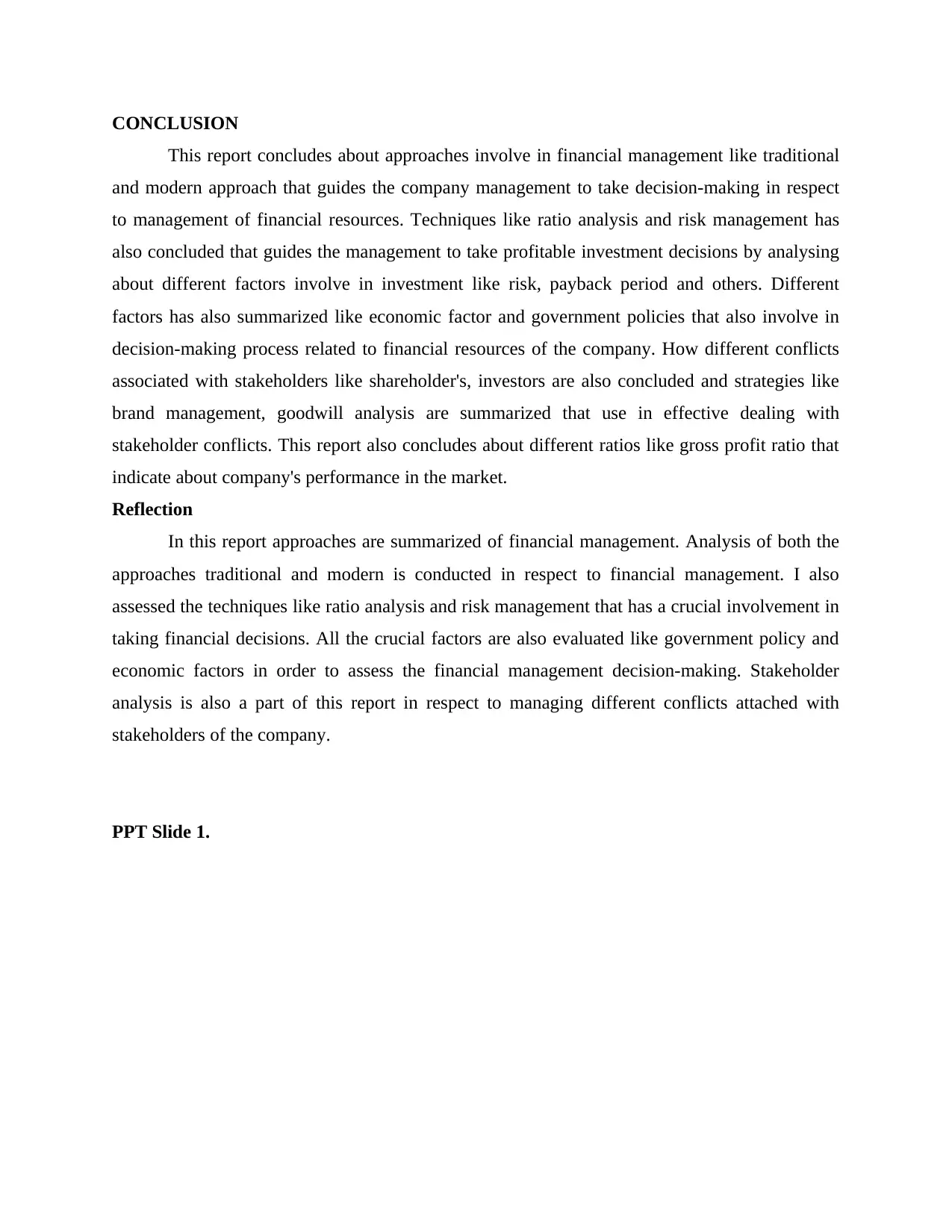
CONCLUSION
This report concludes about approaches involve in financial management like traditional
and modern approach that guides the company management to take decision-making in respect
to management of financial resources. Techniques like ratio analysis and risk management has
also concluded that guides the management to take profitable investment decisions by analysing
about different factors involve in investment like risk, payback period and others. Different
factors has also summarized like economic factor and government policies that also involve in
decision-making process related to financial resources of the company. How different conflicts
associated with stakeholders like shareholder's, investors are also concluded and strategies like
brand management, goodwill analysis are summarized that use in effective dealing with
stakeholder conflicts. This report also concludes about different ratios like gross profit ratio that
indicate about company's performance in the market.
Reflection
In this report approaches are summarized of financial management. Analysis of both the
approaches traditional and modern is conducted in respect to financial management. I also
assessed the techniques like ratio analysis and risk management that has a crucial involvement in
taking financial decisions. All the crucial factors are also evaluated like government policy and
economic factors in order to assess the financial management decision-making. Stakeholder
analysis is also a part of this report in respect to managing different conflicts attached with
stakeholders of the company.
PPT Slide 1.
This report concludes about approaches involve in financial management like traditional
and modern approach that guides the company management to take decision-making in respect
to management of financial resources. Techniques like ratio analysis and risk management has
also concluded that guides the management to take profitable investment decisions by analysing
about different factors involve in investment like risk, payback period and others. Different
factors has also summarized like economic factor and government policies that also involve in
decision-making process related to financial resources of the company. How different conflicts
associated with stakeholders like shareholder's, investors are also concluded and strategies like
brand management, goodwill analysis are summarized that use in effective dealing with
stakeholder conflicts. This report also concludes about different ratios like gross profit ratio that
indicate about company's performance in the market.
Reflection
In this report approaches are summarized of financial management. Analysis of both the
approaches traditional and modern is conducted in respect to financial management. I also
assessed the techniques like ratio analysis and risk management that has a crucial involvement in
taking financial decisions. All the crucial factors are also evaluated like government policy and
economic factors in order to assess the financial management decision-making. Stakeholder
analysis is also a part of this report in respect to managing different conflicts attached with
stakeholders of the company.
PPT Slide 1.
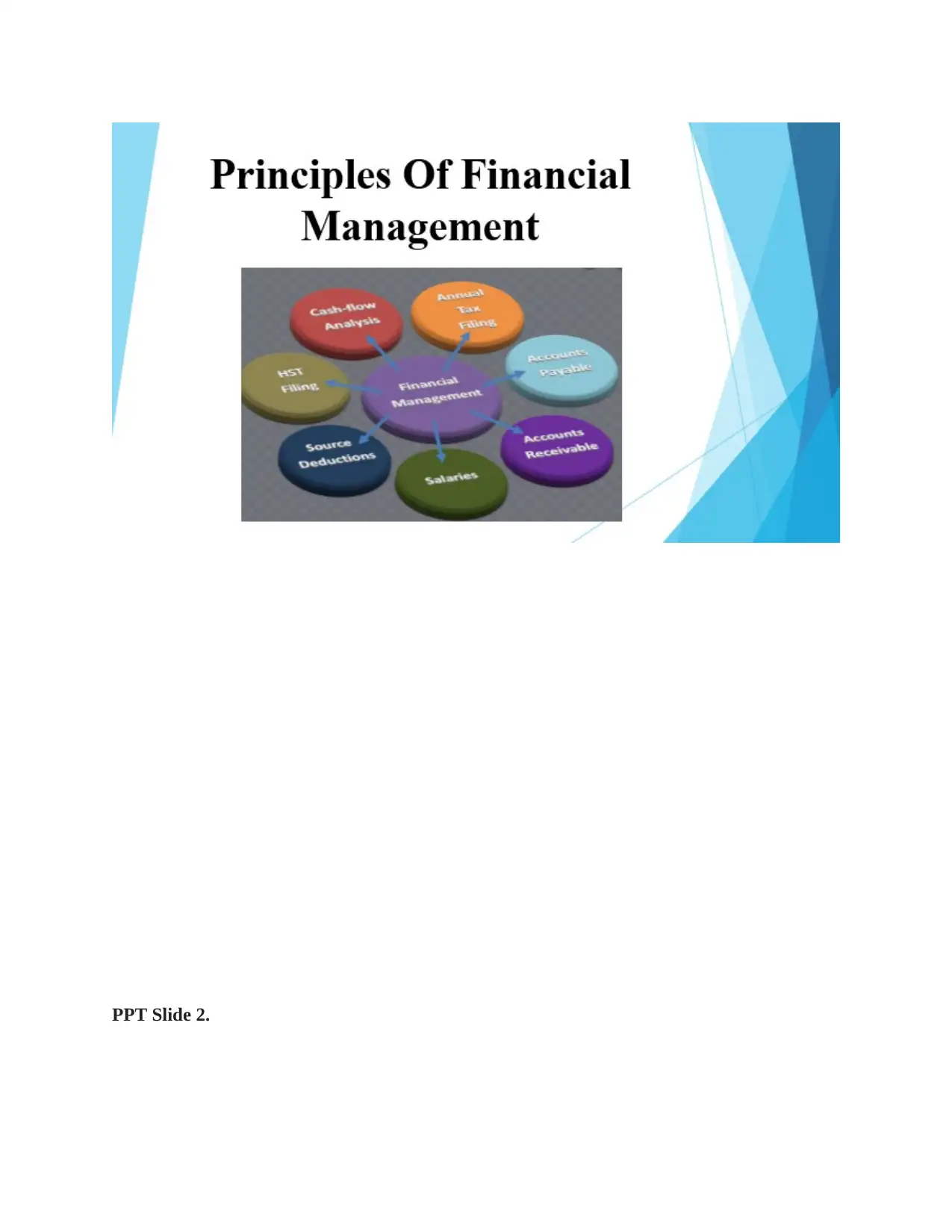
PPT Slide 2.
⊘ This is a preview!⊘
Do you want full access?
Subscribe today to unlock all pages.

Trusted by 1+ million students worldwide
1 out of 18
Related Documents
Your All-in-One AI-Powered Toolkit for Academic Success.
+13062052269
info@desklib.com
Available 24*7 on WhatsApp / Email
![[object Object]](/_next/static/media/star-bottom.7253800d.svg)
Unlock your academic potential
Copyright © 2020–2025 A2Z Services. All Rights Reserved. Developed and managed by ZUCOL.



